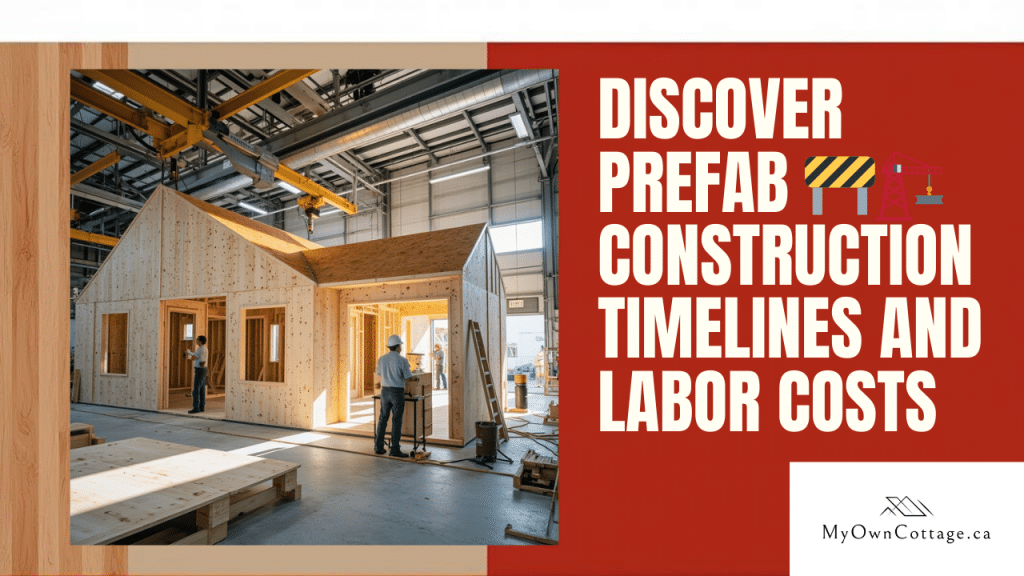Prefab Construction Timelines and Labor Costs in Ontario (2025 Guide)
📅 Last updated: September 10th, 2025
✍️ Written by prefab building specialists at My Own Cottage
Prefab homes in Ontario, often called factory-built homes or modular homes, are gaining popularity due to faster construction timelines and lower costs.
Staying on budget typically comes down to two factors:
Construction timelines — delays quickly increase expenses.
Labor costs — skilled trades and installation efficiency directly affect your final price.
Manage these well, and you maximize the affordability of your prefab home.
📆 Why Prefab Home Timelines & Labor Costs Matter in Ontario
Knowing how long prefab construction takes—and what drives labor costs—helps you set realistic expectations, avoid surprise expenses, and keep your project on schedule.
👉 For a deeper price breakdown, see our comprehensive guide to the cost per square foot of prefab homes in Ontario. It explains price ranges, what’s included, and how prefab compares to traditional builds.
🚧 Factory-Built Homes Timelines in Ontario: How Long Does It Take?
Industry research from CMHC (Canada Mortgage and Housing Corporation) notes that factory-built homes are completed 30–50% faster than conventional builds.
In fact, most Ontario prefab projects finish in 3–6 months instead of 12–18 CMHC, 2024.
The process usually follows four main stages:
Design & Approvals – Creating custom plans and securing municipal permits.
Factory Build – Manufacturing panels or modules in a controlled environment.
Delivery & Setup – Transporting the completed sections to your lot.
On-Site Assembly – Installing the foundation, connecting utilities, and finishing interior details.

This streamlined approach is why one of the most common questions we hear is: “How long does it take to build a prefab home in Ontario?”
To contrast, the exact timeline depends on:
Site preparation (grading, foundation, permits)
Builder efficiency (project management and scheduling)
Prefab type (modular vs. panelized)
For a deeper breakdown of overall pricing, see our guide on whether it’s cheaper to build a prefab home or buy an existing house in Ontario.
💡 Prefab Construction Timelines in Ontario: How Long Does It Take?
Even with an experienced prefab builder, several variables can influence your schedule:
Permitting & Zoning — municipal approvals may take longer than expected.
Site Preparation & Weather — Ontario winters and poor soil conditions can delay work.
Factory Scheduling — manufacturing backlogs may push delivery dates.
Logistics & Transport — oversized modules require precise coordination and, at times, special permits.
⚡ Pro Tip: Ask your builder for a detailed prefab home timeline. A clear schedule helps you anticipate delays and keep the build moving smoothly.
Also, keep in mind that energy-efficient upgrades can affect budgets — see our guide on whether energy-efficient prefab homes cost more upfront.
🏗️ Prefab vs. Traditional Construction Timelines (Ontario)
| Stage | Prefab Construction | Traditional Build |
|---|---|---|
| Design & Approvals | ~1 month | ~3 months |
| Factory / Build | ~2 months | ~6 months |
| Delivery & Setup | ~2 weeks | N/A |
| On-Site Assembly | ~1.5 months | ~6 months |
| Total Duration | 3–6 months | 12–18 months |
Accurate timelines should also include allowances for site preparation and grading, both of which connect closely to how much land impacts prefab home costs in Ontario.
👷♂️ Ontario Prefab Build Cost & Labor Pricing (2025 Guide)
Prefab construction reduces on-site labor by shifting most work into the factory. Total labor cost still varies with the size and complexity of your project.
For a deeper breakdown of overall pricing, see our guide on how much do prefab modular homes cost in Ontario.
Here’s a typical labor breakdown:
Factory workers — build and assemble most of the structure in controlled conditions.
On-site contractors — complete foundation work, utility connections, and interior finishes.
According to the Canadian Home Builders’ Association (CHBA), modular and prefab builds can reduce on-site labor by 20–30% compared to traditional construction due to factory-controlled efficiency CHBA, 2024.
Ontario Prefab Labor Costs: Regional & Contractor Differences
Wage differences — rates in larger cities (e.g., Toronto) are typically higher than in rural areas. This explains why prefab home prices are higher in Toronto compared to smaller cities.
Experience levels — specialized installers and trades command premium pricing.
Customization — unique floor plans and features require more labor and expertise.
These variables help you budget accurately and avoid surprises. Industry data also notes that regional labor shortages can push prices higher.
⚠️ According to prefab housing industry labor statistics in Canada, labor shortages in certain regions may also push prices up.
⚖️ Ontario Prefab Construction: How Timelines Affect Labor Costs
Time and labor are closely linked in prefab construction. Shorter timelines mean fewer hours worked, which helps keep labor costs down.
Conversely, delays—permit holdups, weather, logistics—can drive expenses up quickly.
Rural buyers often benefit from lower wage rates and land costs, as discussed in our guide to prefab home costs in rural Ontario.
💡 Case Study (Ontario Examples):
On-Time Build: A modular home completed in ~20 weeks reduced labor costs by nearly 15%.
Delayed Build: Weather setbacks added ~2 months and roughly $12,000 in extra labor.
Takeaway: efficient planning and scheduling are critical to controlling costs. This is also why it’s important to plan early for permits and utility hookups.
✅ Tips to Avoid Delays & Extra Labor Costs in Ontario Prefab Homes
Here are four ways to keep your prefab home project on schedule and within budget:
Hire experienced builders — specialized teams work faster and reduce errors.
Start permits early — begin municipal approvals in advance to avoid red tape.
Secure financing upfront — ensure payments won’t stall progress at key milestones.
Track progress — use builder-provided timelines or scheduling tools to stay proactive.
These steps save time, reduce stress, and help you protect your budget.
Always secure financing upfront — ensure payments won’t stall progress at key milestones. For more on this, see our guide on how to pay for a prefab home.
💳 Budgeting for Prefab Timelines & Labor in Ontario
Create a budget that anticipates real-world conditions:
Accurate timelines — include buffers for permits, weather, and supply delays.
Labor estimates — request multiple quotes to compare scope and inclusions.
Contingency funds — set aside 10–15% to cover unforeseen costs.
By planning ahead and accounting for these factors, you can stay on track financially and reduce stress during your build.
For a benchmark, review our cost per square foot of prefab homes in Ontario resource to compare labor vs. material costs.
✅ Shorter Prefab Build Times and Lower Labor Costs
Prefab construction offers Ontario buyers faster build times and lower labor costs than traditional homes. To realize those savings, pair a realistic schedule with a disciplined budget.
Prepare early, set clear expectations, and build in safeguards—so you can move in sooner without surprise expenses.
Ready to get started on your prefab project?
Simply book a free consultation, call us directly, or view our design catalogue today.
🧑💼 Request a Free Consultation
📲 Call Us Directly: (705) 345-9337
🏘️ View Our Design Catalogue
✅ Ontario-Built | ⚡ Energy-Efficient | 🏡 Fully Customizable | 🚚 Fast Delivery
Alternatively, for your convenience, you can also simply fill out the contact form below and we’ll get back to you soon! 👇
FAQ: About Prefab Construction Timelines and Labor Costs
How long does it take to build a prefab home in Ontario?
Most prefab homes in Ontario take 3–6 months from order to move-in. Smaller builds can finish in as little as 60 days, while larger, customized homes may take closer to a year. Prefab construction is generally 30–50% faster than traditional builds.
Why are prefab homes faster than traditional construction?
Prefab homes are built in factory-controlled environments while site work occurs in parallel. This simultaneous process, combined with protection from weather delays, allows projects to be completed up to 50% faster than conventional homebuilding.
How much labor cost can prefab construction save?
Prefab homes typically reduce labor costs by 10–25%. By moving most of the work into a factory, fewer on-site hours are needed, lowering wage bills and improving efficiency.
What factors affect prefab project timelines and costs in Ontario?
Timelines and costs depend on project size, customization level, transportation logistics, site preparation, and permits. Larger or highly customized projects require more time and specialized labor, while streamlined builds move faster and cost less.
Are prefab homes cheaper in labor costs than traditional builds?
Yes. Prefab construction reduces on-site labor needs, making it generally more affordable than traditional builds. Actual savings depend on customization, regional wage rates, and contractor availability.
Can prefab projects face delays?
Yes. While prefab minimizes weather issues, delays can occur due to permits, site preparation, transportation challenges, or factory backlogs. These can extend timelines and increase labor costs.
Do labor savings lower the cost per square foot?
Yes. Lower labor needs and faster timelines make prefab homes more predictable and affordable per square foot compared to traditional construction.
What is the typical labor cost breakdown for prefab homes in Ontario?
Labor costs usually include factory workers, on-site installation crews, and transportation staff. Assembly and transport alone may range from CAD $5,000 to $15,000, depending on project size and complexity.
How do transport costs impact prefab building budgets?
Transporting large prefab modules requires specialized equipment and planning, which can add significantly to total project costs. Homebuyers should factor in logistics early when budgeting.
What timeline can modular construction deliver?
Modular builds often finish in 20–50% less time than traditional methods. Small homes may be move-in ready within 30–60 days, while larger or custom projects still benefit from faster delivery.
How does the Ontario climate affect prefab timelines?
Ontario’s winters don’t impact factory production but can delay site preparation, foundation work, and utility connections. Planning builds outside severe weather seasons helps reduce risks of timeline overruns.
🛡️ Verified Third-Party Resources
For added confidence and transparency, here are trusted external sources that support modular homebuilding in Ontario:
Ontario Building Code (O. Reg. 332/12)
Official provincial regulations that govern modular and factory-built homes.Tarion Warranty Corporation
Provides home warranty coverage and builder licensing in Ontario.Canadian Home Builders’ Association (CHBA)
National organization supporting residential construction, modular certification, and best practices.CMHC – Canada Mortgage and Housing Corporation
Federal housing authority offering insights on modular housing affordability, financing, and energy efficiency.Statistics Canada: Housing Data
Data-driven research on Canadian housing trends, ownership, affordability, and construction.


